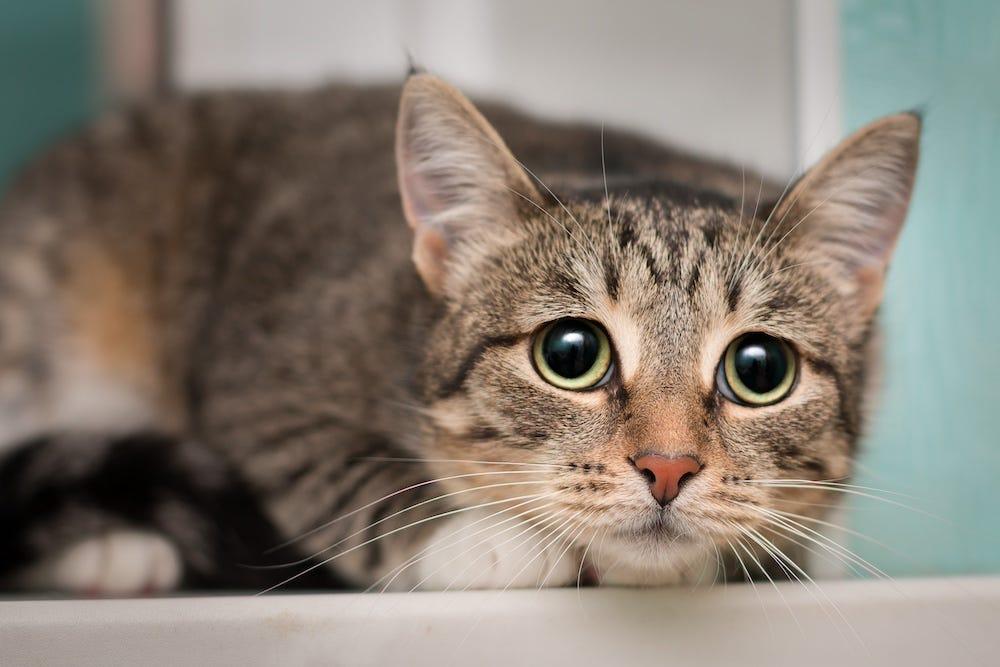Hiding, scrambling, freezing in place. You know how heart-wrenching it can be if you have a scared cat. You think you've created a safe environment for them, but your cat just won't come out of their shell.
Why is your cat so fearful, panicky, and avoidant? And what can you do to help them feel more comfortable? Read on to find out why your cat may be frightened and how you can create a more comfortable home for your skittish cat.

Why is my cat so skittish?
Shy or fearful behavior is most often caused by negative associations made in early life. If a cat doesn't interact with people often or experiences abuse or trauma, later they may be afraid to trust human caretakers and become a skittish cat. Other shy or fearful cats may be that way simply because they're genetically predisposed to higher levels of arousal. For these cats, it will take a long time to calm down and learn to trust new environments and people (which they may never fully do).
Here are some common reasons why cats exhibit fearful behavior. Remember: no one reason is necessarily the only reason your cat is scared.
Your cat is new to you
You were so excited to have a new furry friend in your home, but to your dismay, your cat seems terrified by their new surroundings. A few days or weeks later, your cat shows few signs of settling in. While it could be a number of things, if your cat came to you off the street (as far as you can tell), rule out that they didn't get separated from their original owner and isn't trying to shout, "This is not my house!" Check city and shelter pages online and have a vet check for a microchip to see if an owner can be identified.
Your cat has never lived with humans
Perhaps your cat had some human interaction in a shelter, but without experience living with people, it can be very difficult for a stray feline to get used to a forever home with a human. It takes a great deal of patience and consistency to induce feelings of safety and security in this situation (but it's possible!).
Your cat does not like other animals—or children
Some cats don’t mesh well with other cats, dogs, or small children. Take notice of any fights your shy cat may have had with other pets, and teach children to be gentle and cautious with cats. It may be necessary to delineate a Kitty Zone away from kids' play areas, so you can supervise children's interactions with your new, skittish kitty.
Your cat is poorly socialized
While every cat is different, it is generally considered true that cats need positive human interaction within the first two months of life if they are to be comfortable living with an owner. During this socialization period, it’s important to expose kittens to humans, other cats, and other animals to prevent fear. Kittens handled extensively by people during this impressionable period tend to be friendlier and ultimately less skittish. Beyond that, the regular introduction of new humans can keep them from becoming too shy or scared when they encounter a new person.
Your cat has suffered abuse before
If you don’t know the details of your cat’s history, you might be left guessing whether your scared cat was abused at some point. Unfortunately, once a cat has been mistreated by one human, they’re likely to fear all humans. You may notice that your cat has certain triggers, or experiences that remind them of a negative or abusive incident, that cause them to regress into old ways of coping (i.e., hiding). If this is the case, it is best to avoid triggering your new family member and focus on engaging in activities that promote bonding and trust.

Why is my cat so jumpy all of a sudden?
If your cat is usually friendly, but suddenly begins to hide, make an appointment with your vet. Rule out injury or illness before considering environmental factors that might be making your cat shy.
Cats in pain often isolate themselves. Cats don’t like to be vulnerable when sick or injured, so they'll often hide as a result.
A sudden change in routine or environment—such as adding a new family member or moving to a new home—may also lead to increased skittishness. This will usually fade as your cat settles into the new norm, but be sure to contact your vet if their new anxious behavior persists.
How to help a scared cat feel more comfortable
Provide a calm, manageable environment
You may think it kind to give your cat the freedom to roam your entire home. However, for the skittish kitty, a large domain can be overwhelming. Cats are territorial, so by giving your cat free rein, you're actually giving them a large territory to police and defend.
For the skittish cat, a large domain can be overwhelming.
Moreover, you don't want your furniture, family members, and activities to become terrifying obstacles that stand between your cat and their basic needs.
Make a safe room
Comfort your fearful cat by shrinking their world. Confine your cat to one “safe room” where they can adjust to their new surroundings:
- Choose a quiet room, such as a spare bedroom or other room that isn’t heavily trafficked by people and other animals.
- Provide necessities in this room, including food and water bowls, the litter box, a cat bed, and toys.
- Leave a radio or TV on if you're gone all day and the house is quiet to get your cat used to a normal amount of noise.
Cover hiding places
Part of the goal is to get your skittish kitty used to being out in the open, so cover potential hiding places. (This may mean shoving extra blankets or pillows or bins around the bottom of the bed and around dressers).
Leave your cat's carrier out and place a soft blanket or old T-shirt inside (bonus if it smells like you) to create an "approved" safe spot where your cat can hide out.
This manageable environment should reduce disturbances and help your cat explore more confidently. It's important that your cat can trust that a trip to eat or use the litter box won't make them feel too frightened and exposed. Each feline is different, but your cat will probably remain in this shrunken world for several weeks while you work to build trust and socialize them.
How to get a cat to come out of hiding
Learn how to socialize a cat with the tips below.

1. Slowly introduce yourself
Even though you routinely put food and water in their bowls and clean the litter box—or simply empty the litter box, if you have a self-cleaning litter box like Litter-Robot 4—your cat may still regard you as an intruder into their comfort zone. Begin to introduce yourself slowly and be patient:
- Join your cat in the safe room and sit quietly on the bed or the ground. Don't try to reach out and pet your cat or even call them at first. Just start by being a non-threatening presence and let them come to you when they’re ready.
- Face away and let your cat sniff around you. Slowly, offer a hand to smell. Repeat this for 10-15 minutes 2-3 times per day or as often as you can.
- If the safe room is also your bedroom, come and go as you would normally; you don't have to turn every interaction into socialization practice (and it gives your cat a chance to observe you at your normal speed).
- Work up to talking softly to your cat, but be careful not to make any loud noises or sudden movements. You'll likely see all of your progress evaporate before your eyes!
- When you think your cat is ready, attempt to gently pet their head and around their face. If your cat recoils or retreats, let them. Don't pursue them or try to pick them up. Let them feel completely safe and in control.
2. Create positive associations
If you enter your cat's room and they never approach you, don't get discouraged. Remember: you're up against a lifetime of learning that tells your cat you're scary and threatening. To erode those negative associations, create positive ones.
Offer a special treat to your cat when you enter the space, such as cooked, unseasoned chicken or salmon, or canned tuna.
- If your cat comes over and eats the treat, talk softly and gently.
- If your cat doesn't come over to eat the treat, don't leave it there for them to eat while you're gone. For the socialization process to work, you need your cat to associate the positive experience of the treat with you.
3. Bond through play
As your skittish kitty begins to trust you and accept the treats you offer, start introducing toys and playtime. Bring the toy in with you when you visit, and take it out with you when you leave, so it becomes another item that your feline associates (positively) with you.
- Once your cat has approached you, slowly set the toy on the floor near you. Don't wiggle it at your cat or do much at first; just let them sniff it and get used to it.
- Once they’re interested, slowly pick it up and gently pet them with it around the head and face. If your cat is receptive, let your hand also pet your cat, staying around their face and the top of their head. Maybe that's all you do the first few times.
- Then, as your cat gains more comfort, begin to play and see if they play along. As they begin to play and you're moving the toy around, petting them with it, pet them with your hand, too—then quickly go back to playing. This process will help normalize and create positive associations with touching.
Throughout your playtime interactions, be mindful of your body language. Stay low, so you appear less threatening. As your scared cat learns to trust you and you're able to pet them more and more, try leaving one hand on their back for a few minutes and petting them with the other, then releasing them—this will get them used to more immersive touching.
4. Leave the door open
Once you are playing with your cat regularly, are able to pet them a little, and they’re comfortable eating, drinking, and eliminating regularly, leave the door to the safe room open. If you have other cats, use these steps to introduce your new cat to your resident kitty.
Leave your cat's bowls, litter box, and carrier in the safe room for a week or so and make new feeding and elimination stations where you prefer to have them in your home. When it comes to the litter box, instead of moving it out of the safe room, it's best to place a second one in another location (since it's ideal practice to have more than one traditional litter box per cat, or one self-cleaning litter box for up to four cats). You can even take a scoop of litter from the old one and put it on top of the new litter, so it has a familiar scent.
All of this change will likely cause your cat to behave timidly, so keep up the quiet socialization sessions, so your cat sees that you're still the person you were inside the safe room. Don't get discouraged by setbacks (because there will be many); just stay consistent and devote time to the socialization process.

5. Keep the peace
Now that your cat has graduated and is out of the safe room, keep in mind that every day is an opportunity to erode negative associations and strengthen positive ones.
- Encourage a quieter environment around the house. Loud, sudden bursts of noise can suddenly erase the progress you’ve made and send your cat under the bed for days.
- Speak in calm tones when your cat’s nearby. Never yell at your cat, no matter how they’ve misbehaved.
- During calm moments, try looking at your cat with a soft gaze and blink slowly—you may even see them return the blink, which is great for your relationship.
- Choose toys that allow you to play from a bit of a distance (like wand toys with feathers or balls on string), that can also be used to entice your cat out if they’re hiding.
- Do not swing or throw toys towards a skittish cat, especially when they are not engaged.
6. Don’t get discouraged
Socializing a scared cat is a long process that requires patience, determination, and a big heart. You'll have good days and bad days, but be encouraged by the knowledge that you've created a safe home for your cat that they can rely on. Consistency is key, so continue to practice the tips mentioned here despite changes and setbacks. Throughout your journey, you'll be rewarded by the enormous feeling of pride when your skittish kitty braves a petting session or hops up on the couch next to you and you realize all of your efforts have been worth it.
If you find that these tips are not getting the job done, schedule an appointment with your veterinarian to determine if there are other recommendations in light of your cat’s particular habits. In some cases, a referral to a veterinary behaviorist can make all the difference in encouraging a skittish cat to trust again.
Sources:







